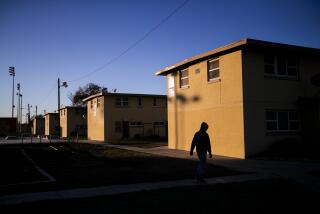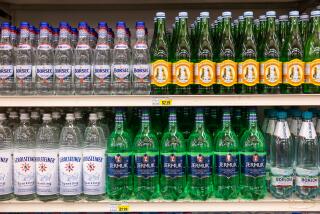DWP Taps Into Drinking Habits : Water: A survey showed that most of its customers drink the bottled variety. The agency wants it known that tap water is safe.
Alarmed by a survey showing that nearly two-thirds of its customers use bottled water or filtration devices instead of drinking straight from the tap, the Department of Water and Power is trying to persuade Los Angeles residents that tap water is safe to drink.
In a letter being mailed this week and next, DWP assures its 1.2 million customers that city water exceeds both state and federal standards and that the department is working to supply even better quality water.
The $400,000 direct-mail campaign is being coupled with an education program for DWP employees at its downtown offices, which includes exhibits on water treatment, tap water quality and taste testing.
“We need to do a much better job communicating to our customers,” said Duane L. Georgeson, the department’s assistant general manager for water. “I am not satisfied that we have a perfect vehicle in this letter, but at least it is a way to get started.”
A survey conducted last spring for DWP revealed that 64% of its customers and 59% of its own employees rely on alternate drinking water sources. Officials have attributed the high numbers to publicity about toxic hazards, including chemical contamination of DWP wells in the San Fernando Valley that supply about one-sixth of the city’s water.
“A lot of people drinking bottled water have a sense, wrongfully, that the tap water may be unhealthy,” said Rick J. Caruso, president of the DWP Board of Commissioners. “We have an obligation as a public agency to tell them otherwise. A lot of poor families are spending an enormous amount of money on bottled water.”
DWP officials said the public information campaign, which is expected to involve more letters in the future, is not an attack on the bottled and filtered water industries. DWP claims that it is not concerned about competition from those industries because drinking water represents only a fraction of 1% of the 210 billion gallons it sells every year.
“It is not an economic issue for us,” Georgeson said. “But it may be for our customers.” The DWP estimates that customers using alternate sources of drinking water pay 800 times more for that water than for the equivalent amount of tap water.
Caruso said bottled and filtered water companies have made DWP’s task more difficult because many of them “support public misperceptions” about the safety of tap water. “It increases their sales,” he said.
But Douglas Nelson of the International Bottled Water Assn., a trade group, said many consumers choose alternate drinking water sources because of “things like taste, smell and how it looks,” not safety concerns. The DWP survey showed that 54% of its customers who chose bottled or filtered water did so for better taste.
“This is a pride thing” for DWP, Nelson said of the direct-mail campaign. “They would like to think they are doing a good job. And generally they are doing a good job.”
The DWP letter, signed by Caruso, is being sent separately from monthly bills in an envelope marked “Important Information on Your Tap Water Quality Inside.” It includes a postage-paid reply card for customers wanting more information, a tour of the department’s purification plant or notification of coming environmental hearings on proposals to cover 10 city reservoirs.
The letter touches briefly on the reservoir issue, which has become a hot topic in several communities opposed to the covers. The letter states that “improvements at our open reservoirs” are part of “efforts to provide you with the highest quality water possible.”
The references have angered some residents involved in the reservoir debate who believe that the department intentionally left out opposing opinions about the effectiveness of the covers.
More to Read
Sign up for Essential California
The most important California stories and recommendations in your inbox every morning.
You may occasionally receive promotional content from the Los Angeles Times.










